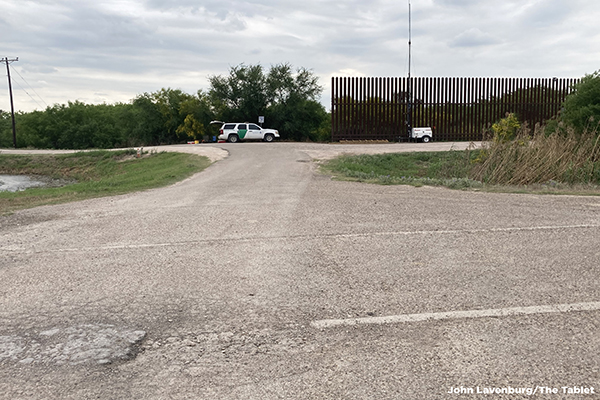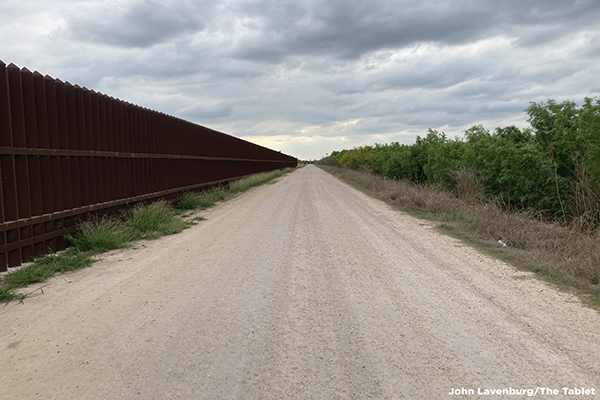HIDALGO, TEXAS — Near the end of S. 15th Street in Hidalgo, Texas, the road turns from smooth pavement to pothole-ridden dirt. Both sides of the street are no longer lined with local neighborhoods, but instead battered fences at the edge of desolate fields.

A short walk up a hill from there, two different realities exist. Local people and families enjoy a bike path, meanwhile, less than a hundred feet away, U.S. Army and Customs and Border Protection man what is considered a hotspot for attempted U.S.-Mexico border crossings.
Not only are their realities different, but their perspectives on the border situation are, too.
“We don’t live that far away, less than a mile from the (Rio Grande River). I work all the way to midnight. I get home around 12:30 a.m. and there’s no activity,” said Elizabeth Gamboa, who has lived in the area since the early 2000s. “I see Border Patrol. They’re sitting there and driving back and forth and that’s all we see.”
At the time of her conversation with The Tablet, Gamboa was on a walk along the bike path with her husband, daughter, and their German shepherd Oso. It’s something they do often, she said, sometimes as late as 8 p.m., and is never a cause for concern.
As she talked about her perspective on the current border situation, and the perception of the people who seek refuge in the States, she recalled the days when she first got to Hidalgo — a Southwest city across the border from Reynosa — in the early 2000s, when migrants would cross through neighborhoods day and night.
Even still, over the years Gamboa remembers only once that a migrant approached her home.
“The other day on the news I heard some people also talking very close and saying they destroy this and they destroy that,” Gamboa said. “I can tell you the only experience I had was a gentleman that stopped by and he only asked for water. I’m sorry, but you don’t decline water to no human being.”

Speaking with The Tablet on the condition of anonymity, a U.S. Army service member stationed at a section of the border near Hidalgo said locals don’t necessarily experience the situation because, with the number of personnel at the border, Border Patrol can “apprehend people really quick,” therefore migrants don’t have a chance to make it into the community.
That service member, and another who was stationed in the same area who also spoke on the condition of anonymity, called the S. 15th Street section of the border a “hot zone.” Especially, they agreed, in the early morning hours between 2 a.m. and 5 a.m.
This past Monday and Tuesday, according to the U.S. Customs and Border Protection, it encountered three groups totaling 320 migrants — 229 family members, 86 unaccompanied children, and five single adults — in Hidalgo County. The migrants’ countries of origin included Honduras, Guatemala, El Salvador, Nicaragua, Romania, Ecuador, Venezuela, and the United Kingdom.
Gamboa doesn’t doubt that a lot of migrants attempt to cross, but her point is that how the situation has intensified in recent months, hasn’t affected their way of life.
She also wants people to recognize that migrants aren’t “just fleeing to come here and bother us. They’re running away from something bigger … in their home countries.” And, as someone originally from Mexico, she especially worries about children making the journey.
“That breaks my heart. It makes me think about my children. I have four,” Gamboa said. “Mexico’s tough being a child by yourself. You don’t know what kind of people you’re going to meet so that’s scary and breaks my heart. I pray for them very often because it’s not easy.”
One of U.S. Army service members said parents often leave their children at the border with the phone number of a family member written down on a piece of paper in their pocket or inside their jacket.
“They leave them at the gate for a better life,” they said.
This particular service member was stationed east of Hidalgo in the Alamo-Donna area. The U.S. side of the dirt road they patrol is miles of open farmland, where they said they don’t experience many crossing attempts.
The Donna Rio-Bravo International Bridge isn’t far from that spot. Nearby, longtime Texan Eucario Alcozer was fixing a beat-up red Suzuki Forenza to bring across the bridge. As he worked on the car’s engine, he told The Tablet he frequents both sides of the border to see family, and isn’t fazed by the current situation.
“It’s blown out of proportion. It always is. People are just going to live their life,” Alcozer said. “Nothing has ever changed. People pretty much are going to keep doing what they’ve been doing for the last century.”

